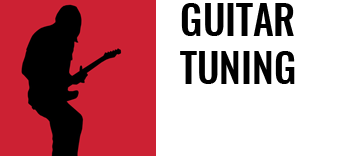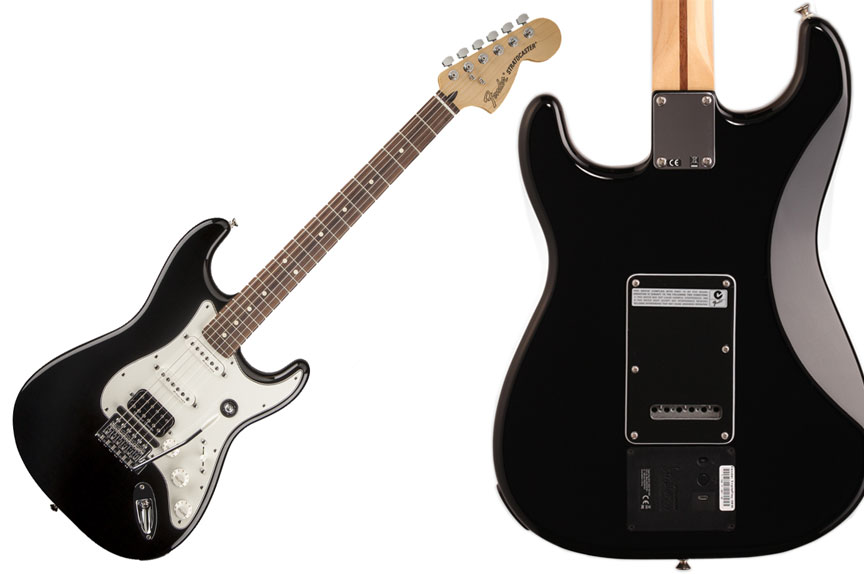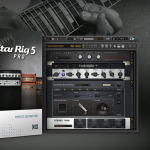MIDI & Digital Guitar
MIDI is data – Audio is sound
Digital Evolution
MIDI stands for Musical Instrument Digital Interface and allows a wide variety of electronic musical instruments, computers and other related devices to connect and communicate with one another. The creation of MIDI in 1983 is closely tied to the development of music synthesizers, and until recently a digital keyboard or controller have typically been used to generate the Note on Note off information that can then be turned into a sound.
Guitarists as well as other stringed instrument players and wind instrument players have not been able to enjoy the full functionality of MIDI like pianists and drummers.
In the more recent years things are slowly improving with a growing number of devices that emerge and disappear all with the aim of providing Note on Note off MIDI communication or some form of analogue to digital conversion where latency times are in audible.
Varying attempts to provide guitarists with the ultimate flexibility of the digital world have been made by some of the biggest music instrument companies such as Yamaha, Fender, Roland and Gibson as well as numerous smaller companies. The penultimate solution has yet to be achieved but a varying array of products using differing techniques are getting closer to it. Here is a selection of some of these products presently making waves!…or MIDI!!
Fishman Triple Play
[column type=”1/2″]
The Fishman Triple Play is one of the more advanced MIDI pick-up systems available today and can be bought to fit on an existing guitar or bought built into guitars like theFender Fishman TriplePlay Stratocaster HSS guitar fender.com
…or the Godin Session Custom TriplePlay godinguitars.com
See a review by Premier Guitar
See a video review by Sweetwater
[/column]
[column type=”1/2″ last=”true”]
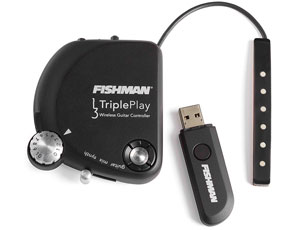
[/column]
[clear]
Jam Origin
[column type=”1/2″]
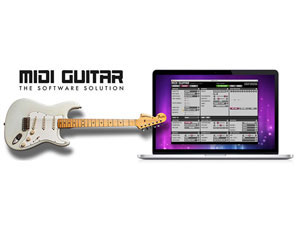
[/column]
[column type=”1/2″ last=”true”]
This is thought to be a game changer by some, MIDI Guitar turns any guitar into a polyphonic MIDI controller. The polyphonic pitch detection system has a pitch prediction method that reduce latency to a unheard new level. It requires no special pickup just plug your guitar into a computer or iOS device through any audio interface and MIDI Guitar lets you control almost any soft synth.
[/column]
[clear]
Roland GR-55 & GK-3
[column type=”1/2″]
The Roland GR-55 is a revolution in guitar synthesis, with features never before available in any guitar processor. In terms of speed, it’s the fastest ever. It’s also the most accurate, thanks to newly developed pitch-detection technology. See more on the synth www.roland.com/gr-55
…or the pickup www.roland.com/gk-3
See a review by Guitarst
[/column]
[column type=”1/2″ last=”true”]
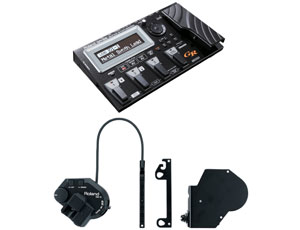
[/column]
[clear]
Jamstick+
[column type=”1/2″]
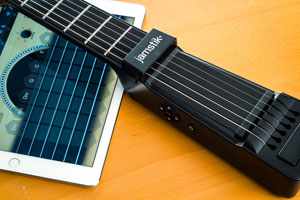
[/column]
[column type=”1/2″ last=”true”]
The jamstik+ is a Bluetooth Smart enabled digital guitar with real strings & frets. It works with your iPad, iPhone or Mac & select Android devices and a multitude of music apps, including an interactive guitar lesson app series, so everyone from beginners to pros can just play.
Bluetooth Smart technology makes for a simple, fast and wireless connection. It’s the lesson-practice-recording studio you can take with you.
[/column]
[clear]
STAR LABS
[column type=”1/2″]
Ztar MIDI guitar from Starr Labs offers unsurpassed ultra high-speed MIDI control for today’s guitarists. The Ztar differs from other guitar synths in that it provides the industry’s only glitch-free, 6-string x 24 fret touch-sensitive keyed-fingerboard; ideal for playing and controlling all aspects of synthesizers, samplers, and sound modules.
[/column]
[column type=”1/2″ last=”true”]

[/column]
[clear]
Roland V Guitar
[column type=”1/2″]
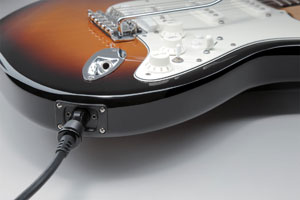
[/column]
[column type=”1/2″ last=”true”]
A company always on the edge of digital innovation is Roland who back in 1977 produced the year the world’s first guitar synth, later partnering Fender in 1995 – they launched its first digital modelling guitar product, the VG-8. Again in 2007 saw a further release with Fender the VG guitar fully kitted out for virtual sound modelling. More recently in 2012 Roland released the VG Stratocaster G-5 with Fender. This time a Mexican made Fender marketed by Roland not Fender.
Roland G-5 guitar
About V guitar
GK 3
Friend Jam free software download
[/column]
[clear]
Line 6
[column type=”1/2″]
It was Line 6 who can lay claim to pioneering digital modelling technology for the mainstream with the POD the worlds first computer based sound modelling device that revolutionized how guitars can be recorded. In 2002 they went on to launch the Variax the world’s first digital sound modelling guitar.
[/column]
[column type=”1/2″ last=”true”]
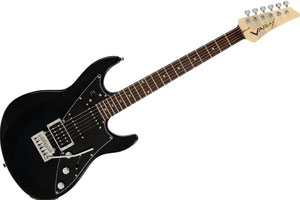
[/column]
[clear]
Fusion guitar
[column type=”1/2″]
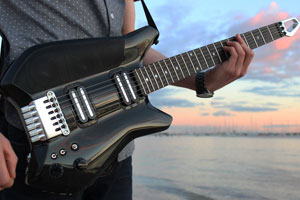
[/column]
[column type=”1/2″ last=”true”]
One of the best sounding travel guitars we’ve tried is Yamaha’s Silent Guitar, which offers a choice of modeled simulated tones or piezo-sourced sounds routed to headphones or an external amp. It doesn’t have its own amp and speakers built-in though, like, say, a Vox Apache. And there’s no Lineage-like smartphone integration to mix in some digital effects. In fact, you might struggle to find all three in one instrument. Unless you stumble across the Fusion Guitar from Melbourne, Australia-based designer and guitarist Dave Auld, which combines an iPhone dock, amplifier, battery and speakers in one futuristic-looking axe.
[/column]
[clear]
Godin guitars
www.godinguitars.com
[column type=”1/2″]
Several years have passed since the first Multiac made its debut and Godin continue to refine their designs and explore new possibilities. There are now twelve Godin models that include synth access.
[/column]
[column type=”1/2″ last=”true”]
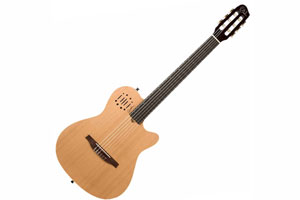
[/column]
[clear]
Moog guitars
[column type=”1/2″]
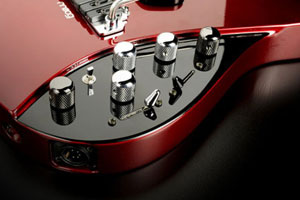
[/column]
[column type=”1/2″ last=”true”]
The Moog Guitar: winner of Guitar Player Magazine’s 2009 Reader’s Choice Award, Electronic Musician Magazine’s 2009 Editor’s Choice Award; 2008 Summer NAMM “Best In Show”; a 2008 “Best of What’s New Award” from Popular Science Magazine and a 2009 Mix Foundation TEC Award. More importantly, it has inspired players to new creative heights, and opened the door to totally new forms of expression with a guitar.
[/column]
[clear]
You rock Guitar
[column type=”1/2″]
The YRG is a MIDI guitar for recording, composing, and creating tablature via MIDI. It can also be used stand-alone with its internal sounds. The YRG’s patented fingerboard technology and electronics have revolutionized the way a guitar player, other aspiring musician or DJ can create, record and play music. The YRG connects to a host of mobile devices including the popular iPad to use with GarageBand. It also connects via USB to the MAC and PC. The YRG can be used with most recording and tablature software such as Logic, Reason and Ableton to name a few. Also compatible with Legacy MIDI synthesizer devices via its 5-pin MIDI connector.
[/column]
[column type=”1/2″ last=”true”]
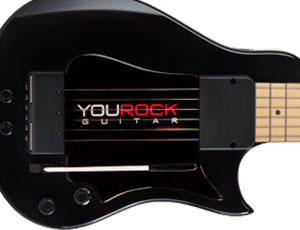
[/column]
[clear]
Lineage Guitar
[column type=”1/2″]
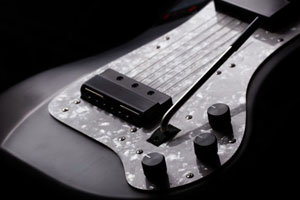
[/column]
[column type=”1/2″ last=”true”]
This MIDI guitar is one of the latest contenders and boost some good performance charactoristics. The Lineage MIDI Guitar is the next step in the evolution of guitar to MIDI. Building upon the patented and proven technology of the YRG, Inspired Instruments aims to satisfy modern high end studio and performance needs.
Review
www.gizmag.com
[/column]
[clear]
Latency
One of the main stumbling blocks at arriving at an established digital playground has been the problem of overcoming latency, but this issue takes on a different form if note on note off information is transmitted instead of analogue (wav.) as it is so much lighter.
Digital v’s Analogue
Another problem is providing a realistic enough digital replication of a classic value amp with its respective pedals.
A valve amp will always have a place for producing pure rich tones right off your finger tips and no one is suggesting otherwise and it can even be recorded into a DAW as a wav. file. But as the digital world improves its’ technology by increasing sampling rates, producing better processing speed and bit rates there is great deal of versatility and functionality that can be done digitally even if your finished work ends up in a studio and is recorded in analogue.
MIDI and digital can help
Obviously there are levels and levels off professionalism and varying schools of thought on how someone may address guitar playing, but making use of a simple DAW set-up can have a number of advantages.
MIDI and digital units can provide a large amount of versatility and functions at relatively affordable prices. From effects processing to song writing, learning and recording there are endless possibilities. With such things like virtual sound modeling, notation software and the concept of transferring note on note off information directly from a guitar pick-up all improving and becoming more affordable the creative environment for guitarists is slowly expanding.
On-Line listing at Sweetwater
sweetwater.com
